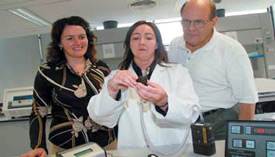| 2005 |

|
YEAR BOOK |
National University of Ireland, Galway
|
How clean is clean?
– NUI Galway research aims to provide more effective clean-up techniques for chemical and pharmaceutical industries
|

As part of a minor MSc research thesis in Occupational Hygiene at NUI Galway, a statistically robust study of the decontamination efficacy of two cleaning techniques, the traditional 'deluge' and another technique known as 'fog mist'*, was carried out. The research project was part of a joint collaboration between the Air Quality Technology Centre, NUI Galway and an Eli Lilly manufacturing facility in Indiana, USA. The average surface cleaning efficiency obtained when using both methods was similar, however the study showed that horizontal surfaces tend to be more difficult to clean when compared with vertical surfaces. The study also demonstrated that greater cleaning efficiencies can be achieved when the contamination is visible to the person conducting the cleaning, compared with a 'non visible' contamination which may occur as a result of inadequate cleaning or a small leak in the workplace.
The study showed that the visual assessment of a surfaces' cleanliness post cleaning is a very important part of a cleaning procedure as although surfaces may appear visually clean after cleaning with either fog mist or deluge, swab samples and air concentration data can provide valuable information on residual contamination that is still present. Overall the study suggests that the qualitative assessment of surfaces post spill clean up with fog mist or deluge could be used in place of analysis if the chemical or pharmaceutical compound has an occupational exposure limit of greater than 1 µg/ m 3 .
The results of the study will help measure the day to day decontamination performance and clean up efficiency of the two techniques. This study is very relevant to Irish Industry as many of the major pharmaceutical and chemical companies have located their manufacturing facilities here. Recently the project received an award at the American Industrial Hygiene conference, 'Best AIHce 2005 exposure assessment strategies poster presentation' and 'second best AIHCE 2005 conference poster presentation'.
*Fog Mist: Using a pressurized water canister, deionised water and a specially designed delivery lance, the contaminant is covered in a cloud of fine water fog (droplets 1-10 micrometers in diameter), followed by a spray/mist of water droplets 1-10 micrometers in diameter.
Contact details: Dr Marie Coggins or Dr. Miriam Byrne, Department of Experimental Physics, NUI, Galway;
E-mail: [email protected] [email protected]